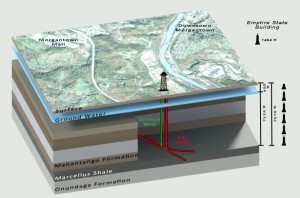The MSEEL Project — The MSEEL site will provide a well-documented baseline of reservoir and environmental characterization. Access to multiple Marcellus wells separated by sufficient time to analyze data will allow for the collection of samples and data, and the testing and demonstration of advanced technologies. The project’s phased approach allows for flexibility to identify and incorporate new, cost-effective technology and science focused on increasing recovery efficiency, while reducing environmental and societal impacts.
1. Demonstrate the Best Approach to Drill, Complete and Produce a New Horizontal Well That Minimizes Any Environmental/Social Costs While Maximizing Economic Productivity
2. Monitor and Document Impacts in a Controlled Environment on: Greenhouse Gas Emissions, Local Air Pollution, Water Supply and Quality, Noise and Activity, and Societal Impacts
3. Develop New Technologies in: Microseismic Monitoring, Production Monitoring and Advanced Logging
4. Develop New Scientific and Engineering Approaches to Apply to Multi-disciplinary and Multi-institutional Natural Resource Studies
The Team — MSEEL research team is a collaborative overview team from West Virginia University and the Department of Energy.
Research and Work Overview — The objective of the MSEEL project is to gain a better understanding of the unconventional shale reservoirs through advanced reservoir characterization and monitoring of horizontal wells. Research will also focus on societal and envrionmental impacts of shale gas development.
Deep Subsurface Rock, Fluids and Gas — Research will evaluate molecular, isotopic, geochemical, microbial, noble gas and physical characterization of core, fluids and gases.
Geophysical and Geochemical Aspects — Research will evaluate relation of production to microseismic event distribution.
Surface Environmental Studies — Characterize temporal changes in liquid and solid wastes, air light and noise. Identify exposure pathways. Develop protective management and treatment strategies.
Economic and Societal Considerations — Research will evaluate governmental economic and societal impacts.
NATURAL GAS PRODUCTION — In addition to the one vertical “scientific well” shown in the diagram above, there are four so-called horizontal wells that were drilled and fracked by Northeast Natural Energy of Charleston, WV. These produced raw natural gas as follows: 3H had 5,000 MMCF of cumulative production to June 30, 2021, 4H had 3,000 MMCF, 5H had 4,200 MMCF, and 6H had 1,500 MMCF. (These values are approximate.)
NOTE ADDED ~ According to the National Energy Technology Laboratory engineering staff, the overall MSEEL project ends on December 31, 2021. Then, a final report is due to the U.S. Department of Energy in thirty days. Following an internal review by the U.S. government, the final report will be placed with the Office of Scientific & Technical Information of the U. S. Department of Energy for general access and use.

